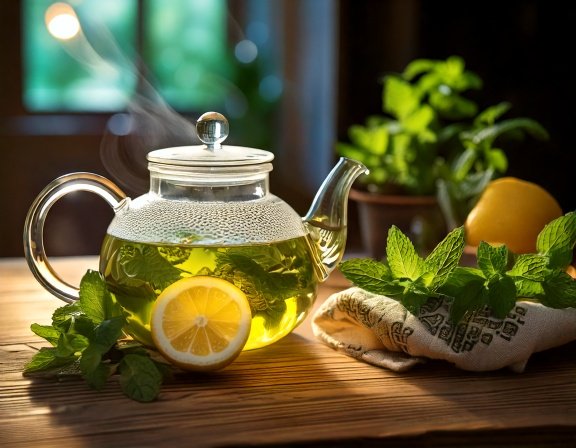Peppermint in Your Garden: Step-by-Step Guide to Growing, Harvesting & Using for Digestive Relief

Peppermint (Mentha × piperita) is a gardener’s favorite—easy to grow, refreshingly aromatic, and a natural remedy for digestive troubles. A fresh sprig from your garden can ease bloating, calm an upset stomach, and refresh your senses. This guide shows you how to plant, care for, harvest, and use peppermint for digestive relief and daily wellness.

How to Grow Peppermint: Step-by-Step
Peppermint is one of the easiest herbs to grow, making it perfect for both beginner and seasoned gardeners. Its vigorous nature and refreshing scent bring instant life to any garden bed or container. The key is giving it the right start and just enough space to thrive. Peppermint loves moist, well-draining soil and partial to full sunlight—plus, it spreads quickly, so a container or designated area helps keep it under control. Follow these simple steps to grow a lush, fragrant peppermint patch right at home.
Step 1: Choose the Right Spot
Pick a sunny or lightly shaded location with well-draining, rich soil. Peppermint can tolerate a range of conditions but thrives best where it gets at least 4–6 hours of light daily.
Step 2: Planting
You can start peppermint from cuttings or nursery plants. Space them about 18–24 inches apart to allow room for spreading roots. Keep the soil consistently moist but not soggy during early growth.
Step 3: Watering & Feeding
Water regularly—especially during dry spells—to maintain even moisture. Feed occasionally with a mild organic compost or liquid fertilizer to encourage full, leafy growth.
Step 4: Controlling Growth
Peppermint spreads fast! Plant it in containers or raised beds to prevent it from overtaking nearby herbs. Regular trimming also keeps the plant bushy and aromatic.
Step 5: Harvesting
Begin harvesting when the plant reaches about 8–10 inches tall. Cut stems just above a leaf node to encourage regrowth and continued production throughout the season.
Traditional Medicinals Organic Peppermint Tea
Soothes your belly, refreshing and minty. A caffeine-free herbal classic with 96 tea bags (6 pack) for daily digestive relief.
Shop Peppermint TeaDisclosure: We may earn a small commission on qualifying purchases.
Finessa: Plant-Based Gut & Liver Support
- Features Taraxacum, Silymarin (Milk Thistle), Cascara, Cynara (Artichoke), Turmeric, Licorice, Probiotics
- High in polyphenols and active plant compounds
- Crafted for gentle cleansing and total digestive harmony
When & How to Harvest Peppermint
Harvesting peppermint at the right moment ensures maximum flavor, aroma, and therapeutic strength. The best time to cut your peppermint is just before the plant begins to flower—when its leaves are rich with essential oils that deliver that crisp, cooling sensation. Use clean shears to snip the stems about an inch above the base, preferably in the morning after the dew has evaporated but before the sun is too strong. This helps preserve the oils that give peppermint its refreshing scent and potency.
Once harvested, gather the stems into small bundles and hang them upside down in a shaded, well-ventilated space. When the leaves feel dry and crumbly, strip them from the stems and store them in airtight glass jars away from direct light or heat. Properly dried peppermint will keep its bright aroma and medicinal value for months—perfect for brewing digestive teas, soothing baths, or natural home remedies whenever you need a breath of calm refreshment.
Harvest Time: Begin harvesting once plants are 6–8 inches tall, ideally just before flowering for peak oil content.
Harvest in the morning after dew dries for best aroma.
How to Harvest: Snip stems above leaf nodes to encourage regrowth. Use fresh immediately or dry in small bundles in a cool, dark place.
Storing: Dried leaves in airtight jars away from sunlight last year-round.

Traditional Medicinals Organic Peppermint Tea
Soothes your belly, refreshing and minty. A caffeine-free herbal classic with 96 tea bags (6 pack) for daily digestive relief.
Shop Peppermint TeaDisclosure: We may earn a small commission on qualifying purchases.
Simple Home Remedies with Peppermint
Peppermint is at its most flavorful and medicinally potent when harvested just before it begins to flower. This is when its essential oil content—responsible for that refreshing scent and cooling effect—is at its peak. Snip the stems about an inch above the first set of healthy leaves, ideally in the morning after the dew has dried but before the midday sun. This helps preserve the plant’s natural oils and ensures a more vibrant aroma and taste.
After harvesting, bundle the stems and hang them upside down in a shaded, airy spot to dry. Once crisp, remove the leaves and store them in an airtight glass jar away from heat and light. Proper drying not only keeps the flavor strong but also helps the peppermint retain its digestive and soothing properties for months of tea-making, infusions, and homemade remedies.
- Peppermint Tea: Steep 1–2 tbsp fresh (or 1 tsp dried) leaves in hot water 5–10 minutes; sip for bloating, gas, or nausea.
- Peppermint Infused Water: Add fresh leaves for a cooling digestive drink.
- Homemade Peppermint Oil: Infuse fresh leaves in carrier oil; use for gentle abdominal massage to ease cramps or indigestion.
- Herbal Compress: Soak cloth in strong peppermint tea, cool slightly, place on abdomen for soothing relief.
- Culinary Uses: Add fresh mint to fruit salads, smoothies, or yogurt for digestive-friendly treats.
Did You Know?
Peppermint’s active ingredient, menthol, helps relax intestinal muscles—one of the world’s oldest remedies for tummy troubles!
Ready to Grow Your Own Peppermint Remedy Garden?
Subscribe to Health Intel DailyVivoGut: Relief & Support for Your Gut Health
- Targets bloating, sluggish digestion, and discomfort
- Supports a healthy microbiome and digestive balance
- Helps restore comfort after heavy meals or stress